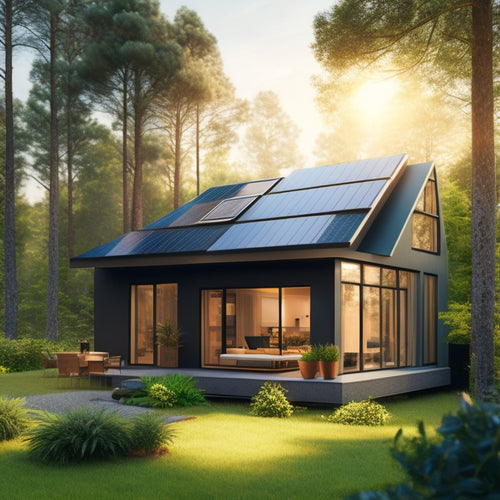
Why Efficiency Gaps Exist in Renewable Energy Systems
Share
You're wondering why efficiency gaps exist in renewable energy systems, specifically in solar panel systems. It turns out that various factors contribute to these gaps. Energy losses occur due to reflection, thermalization, and recombination, while degradation over time and faulty electrical connections exacerbate the issue. Inefficiencies in design, such as low-quality materials and wiring configuration, also play a significant role. Environmental factors like temperature, humidity, and air quality impact efficiency as well. Human error during installation and inadequate supervision further compromise performance. Understanding these factors is essential for optimizing renewable energy systems - and that's just the beginning.
Key Takeaways
• Efficiency gaps exist due to solar panel energy loss factors like reflection, thermalization, and recombination, which reduce energy output.
• Inefficiencies in solar panel design, such as low-quality materials and poor wiring configurations, compromise energy absorption and output.
• Environmental factors, including temperature, humidity, and air quality, significantly impact solar panel efficiency, reducing energy production.
• Human error during installation, such as poorly secured panels and incorrect wiring, can reduce energy output and compromise system performance.
• Failure to implement data-driven optimization strategies, such as predictive maintenance and real-time monitoring, can exacerbate efficiency gaps in renewable energy systems.
Solar Panel Energy Loss Factors
When you assess the efficiency of a solar panel system, you'll find that several factors contribute to energy losses, including reflection, thermalization, and recombination. These losses can greatly reduce the overall energy output, making it important to understand and address them.
One key aspect to think about is panel durability. Solar panels are exposed to harsh environmental conditions, which can lead to degradation over time. This degradation can cause energy leakage, resulting in reduced energy output. Energy leakage occurs when the solar panel's electrical connections or seals fail, allowing energy to escape.
To minimize energy loss, it's vital to ensure panel durability through proper installation, maintenance, and quality control. By doing so, you can reduce energy leakage and maximize the energy output of your solar panel system.
Inefficiencies in Solar Panel Design
While ensuring panel durability is essential, another significant factor affecting solar panel efficiency is the design itself, which can harbor inefficiencies that compromise energy output.
You might be surprised to learn that even the most advanced solar panels can fall victim to design flaws. One common issue is the choice of panel material. For instance, using low-quality materials can lead to reduced energy absorption, ultimately affecting overall efficiency.
Additionally, the wiring configuration also plays a critical role in efficiency. A poorly designed wiring system can lead to energy losses due to resistance and heat buildup.
As you explore the intricacies of solar panel design, you'll realize that even minor inefficiencies can add up, resulting in significant energy losses. For instance, using thicker wires or optimizing the panel's electrical layout can minimize energy losses.
Environmental Impact on Efficiency
As you explore the world of renewable energy, you're likely to discover that environmental factors play a vital role in solar panel efficiency. Environmental factors, including temperature, humidity, and air quality, can greatly impact solar panel efficiency, with even a 1°C increase in temperature reducing energy output by up to 0.45%. This is because high temperatures can cause a decrease in the panel's electrical conductivity, leading to reduced energy production.
Additionally, humidity and air quality can also affect panel efficiency, as dirt and debris can accumulate on the surface, blocking sunlight and reducing energy output.
Climate dynamics, such as changes in temperature and precipitation patterns, can also impact solar panel efficiency. For instance, areas with high temperatures and low humidity may experience reduced energy output, while areas with mild temperatures and high humidity may experience increased energy output.
In addition, maintaining ecological balance is important in reducing the environmental impact of solar panels. By understanding the interplay between environmental factors and solar panel efficiency, you can optimize energy production and reduce the carbon footprint of renewable energy systems.
Human Error in Installation Process
In addition, you'll need to take into account human error in the installation process, which can lead to reduced efficiency in solar panel systems, as poorly secured panels or incorrect wiring can compromise energy output. When installers lack the necessary training or experience, they may inadvertently introduce defects that impede energy production. Additionally, inadequate supervision during the installation process can exacerbate these issues, allowing mistakes to go unnoticed.
Some common mistakes that can occur during installation include:
-
Misaligned or loosely secured panels, which can reduce energy output by up to 10%
-
Incorrect wiring or electrical connections, leading to energy losses and potential safety hazards
-
Failure to properly seal or insulate connections, allowing moisture to seep in and compromise system performance
Data-Driven Optimization Strategies
By leveraging data analytics and advanced monitoring tools, you can identify and rectify efficiency gaps in your renewable energy system, optimizing its performance and energy output. This data-driven approach enables you to pinpoint areas of improvement, reducing energy losses and increasing overall system efficiency.
| Optimization Strategy | Description |
|---|---|
| Predictive Maintenance | Uses machine learning algorithms to detect potential equipment failures, reducing downtime and increasing overall system reliability. |
| Performance Benchmarking | Compares your renewable energy system's performance to industry benchmarks, identifying areas for improvement. |
| Energy Forecasting | Utilizes predictive analytics to forecast energy output, enabling you to optimize energy trading and reduce uncertainty. |
| Real-time Monitoring | Provides instant visibility into system performance, enabling swift identification and rectification of efficiency gaps. |
| Machine Learning-based Optimization | Employs machine learning algorithms to optimize system performance, identifying and addressing efficiency gaps in real-time. |
Frequently Asked Questions
How Does Energy Storage Impact the Efficiency of Renewable Energy Systems?
As you explore the world of renewable energy, you'll find that energy storage greatly impacts efficiency, particularly when considering battery lifespan, which directly affects grid resilience, ultimately influencing the overall performance of your renewable energy system.
Can Renewable Energy Systems Be Integrated With Existing Infrastructure?
As you integrate renewable energy systems with existing infrastructure, you'll reach grid parity when the cost of renewable energy matches traditional sources, but a thorough infrastructure overhaul is necessary to guarantee seamless integration and maximum efficiency.
What Role Does Policy Play in Promoting Efficient Renewable Energy Adoption?
You explore how policy drives efficient renewable energy adoption, recognizing that effective regulatory frameworks and incentivizing innovation are essential in bridging the gap between available and actual renewable energy capacity, ultimately fostering a sustainable future.
How Does the Intermittency of Renewable Sources Affect Energy Efficiency?
You face the challenge of intermittency in renewable sources, which affects energy efficiency due to weather patterns, impacting grid reliability and causing power fluctuations, ultimately reducing capacity factors and making it difficult to maintain a stable energy supply.
Can AI and Machine Learning Improve Renewable Energy System Efficiency?
'Practice makes perfect,' so let's get started! You can leverage AI and machine learning to optimize renewable energy system efficiency through predictive maintenance, data visualization, and real-time monitoring, ensuring maximum output and minimizing downtime.
Related Posts
-

10 Essential Bike Lane Safety Features to Consider
You're designing a bike lane with safety in mind, and that's essential. The National Highway Traffic Safety Administr...
-

7 Ways to Save on Residential Home Solar Panels
You can save thousands on your residential home solar panels by leveraging financial incentives, dealer offers, and s...
-

Reduce Solar Panel Cost for Your Small Home
By evaluating your energy needs, choosing the right installer, and selecting cost-effective solar panel options, you ...


